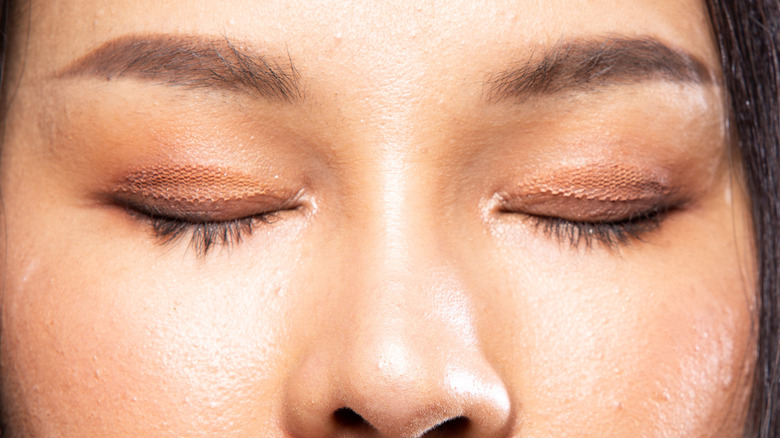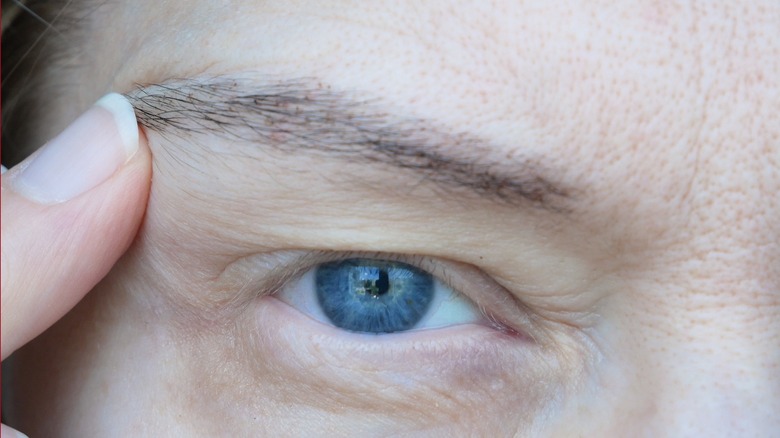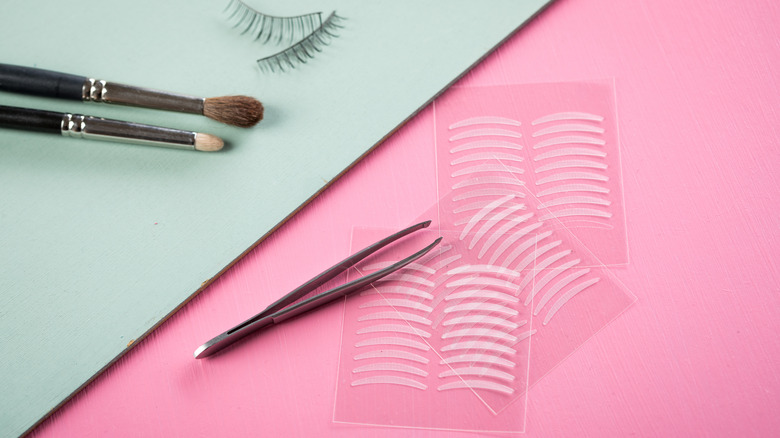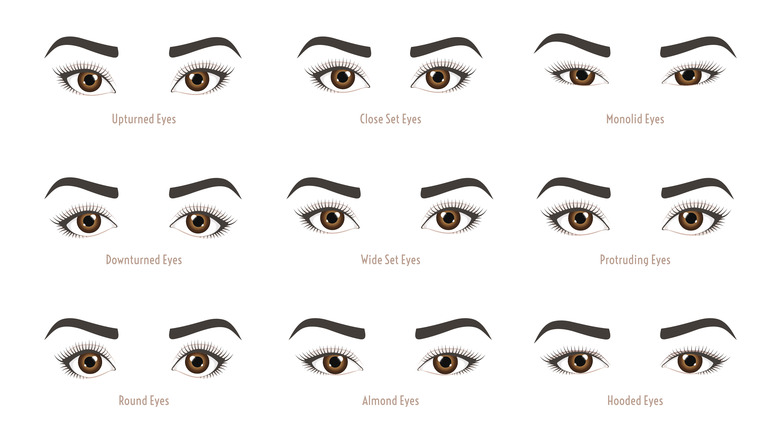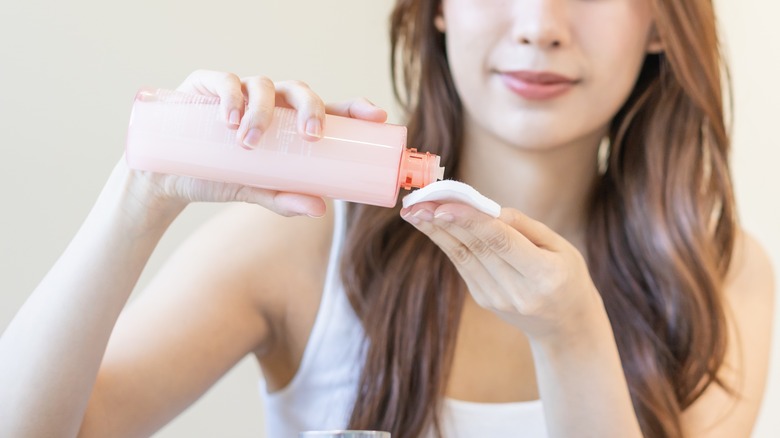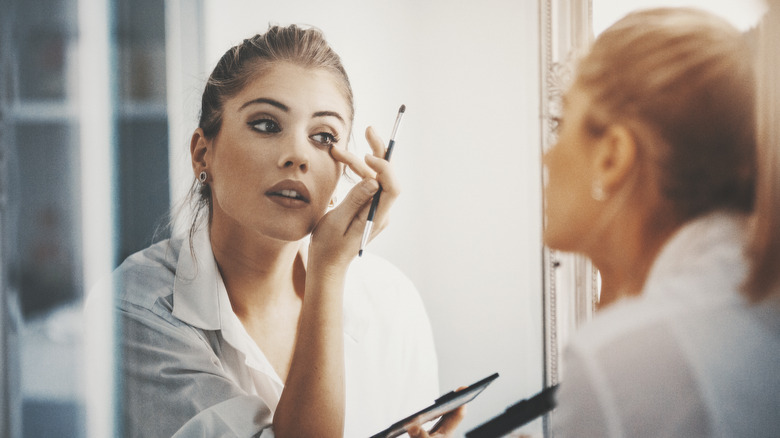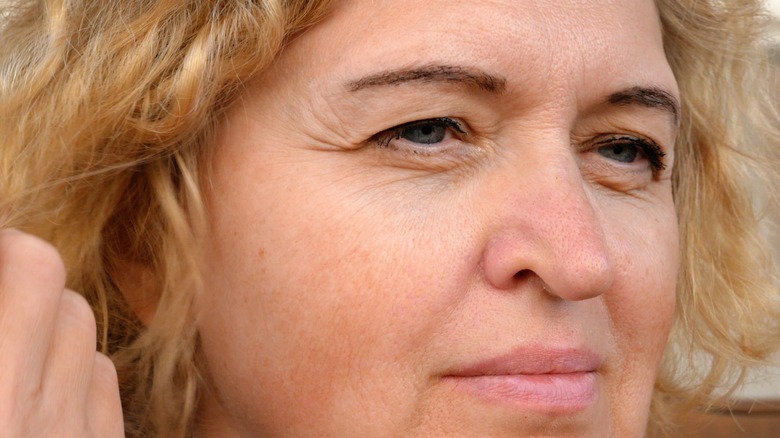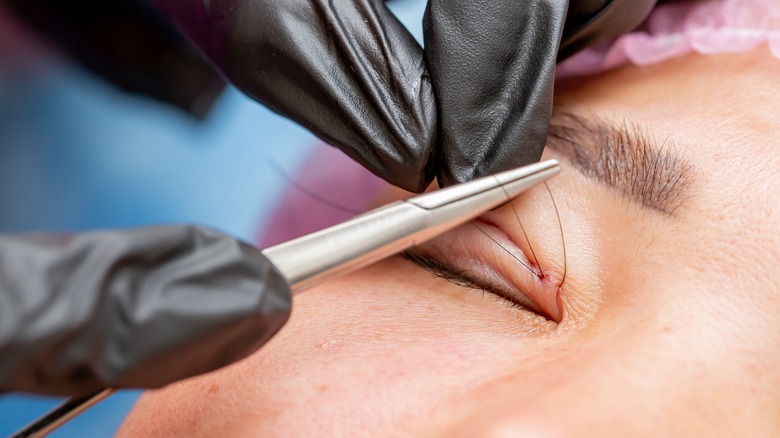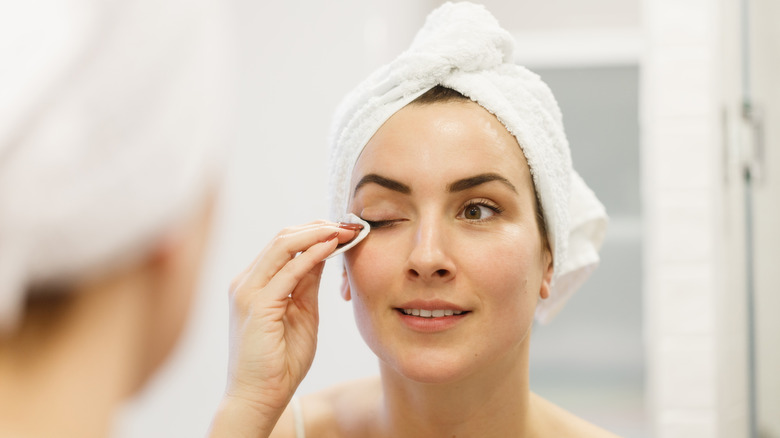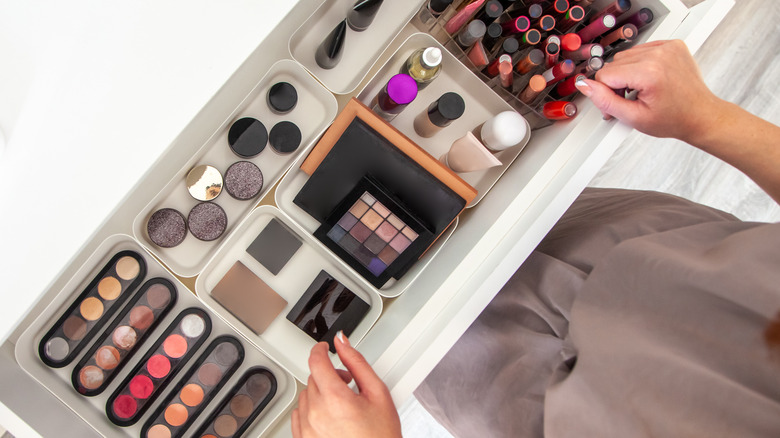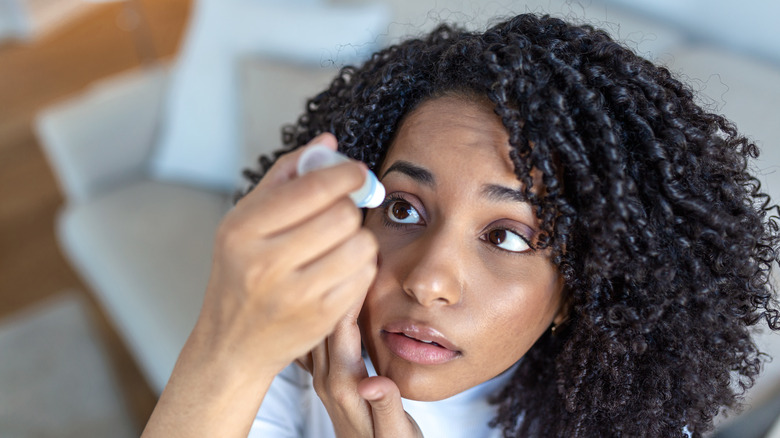The Ultimate Guide To Eyelid Tape
If you follow any beauty bloggers, you probably haven't missed the rising popularity of eyelid tape. The trend actually has older origins, though, dating back to the 1970s and possibly beyond with the advent of eyelid tapes and glues in Japan. The focus behind this fad may have come from a Japanese concept called ninsō — the art of face reading, wherein the shape and size of one's eyes fit into categories that alluded to certain personality traits. For instance, people with big eyes were considered more outgoing and confident. However, later the idea became a means for companies to sell products based on eye type.
Eyelid tape is a tool that allows you to temporarily change or enhance your eye shape. It's essentially an adhesive strip that is placed on the upper eyelid. Specifically for people with monolids — lids that lack a crease — the tape can create the appearance of a double eyelid, making the eyes look bigger or stand out. And for those with double eyelids, it can help to reduce drooping or sagging that may come with aging or other issues.
This tape, as we will discuss, comes in a variety of materials and colors designed to match your eyes and help you achieve the look you want. While it's generally a safe and easy-to-use product, there are a few things you need to keep in mind to make the most of this trend.
Why use eyelid tape?
There are several aesthetic areas that eyelid tape can fix, starting with uneven eyes. This, according to facial plastic surgeon Dr. Steven Dayan's website, is often caused by genetics or aging. In most cases, the eyes themselves are symmetrical, but because one eyelid is slightly drooping, it seems like they aren't the same. The effect can be minimal, but this is probably the case if you've ever noticed that one eye seems smaller than the other. However, if this development is sudden, it may be a sign of an underlying condition such as ptosis.
So why does this happen, and how can eyelid tape help? The orbicularis oculi muscle, as described in the Archives of Facial Plastic Surgery, is the muscle responsible for allowing the eyelids to close and open. Since this muscle eventually loses its elasticity over time, drooping begins to occur.
Eyelid tape cannot stop the process of aging, but what it can do is help compensate for weakening muscles by holding up the skin for us. It's a good alternative to eye surgeries and can help make the eyes look younger and more rejuvenated. It's also a brilliant option for achieving different makeup looks, showcasing the eyes, and helping to boost confidence if your eyes are something you feel insecure about.
Types of eyelid tape: Pros and cons of each type
There are three types of eyelid tapes: single-sided, double-sided, and rolled tape. Single-sided tape is a one-sided adhesive strip that helps to create a double-lidded crease for people with monolids. Conversely, double-sided tape is a good fit for those with hooded eyes or double lids, who want to fix uneven eyes, or sagging.
Lastly, rolled eyelid tape is similar to athletic tape. You cut as much as you need and can shape it to the exact size of your eye. Some rolled tapes are already adhesive, but others require you to buy the glue separately, so it might be a good option for those with sensitive skin because you can choose from brands that offer sensitive skin glues (those designed for lashes will usually do the job).
You also have the option of clear or nude, as well as a few choices for the material. Most eyelid tapes are either medical-grade adhesives, fiber (lace or mesh), or silicone tapes. While the medical grade kind is probably the most long-lasting, it can be irritating for some people. Alternatively, silicone may be a better option for sensitive skin as it's usually waterproof and hypoallergenic. The fiber kind is very comfortable, but you have to be careful not to get it wet as it may slip off. In short, all can be an affordable and instant solution to achieve your desired look. However, always inspect the tape upon arrival to ensure it's clean and safe for use.
How to choose the right eyelid tape for your eye shape
When applying eyelid tape for the first time, it's good to know what eye shape you have. This can help you decide what kind of tape will suit your eyes and give you an idea of how long the tape should be. For round eyes, a long tape may protrude from the sides because the tape is too long, so a shorter or rounded tape might be a better option.
If your eyes have a downturned shape, applying tape to the outer edge of the eyelid can create a lifting effect. Conversely, for upturned eyes with a lower inner corner, applying tape to the inner edge may be more effective. While single-sided tape is ideal for monolids and double-sided tape for double lids, some people may have partial eyelids or ones that taper off at the corners, so experimenting with different options is recommended to find the best fit.
Moreover, as we mentioned, some can cause irritation. To test this out, apply the tape to your hand first and try removing it after a few hours. Note any irritation or if you struggle to remove the adhesive, as this might indicate that another tape is a better choice for you. The tape should stick to the skin but should not be painful to take off. During experimentation, you can also try blending your makeup with the tape to see how it looks and ensure it matches your complexion.
How to apply eyelid tape step by step
The first step in applying eyelid tape is to prepare your eyes, meaning you should clean them to remove any dirt or oils that can impede the tape from sticking. Begin by using a toner or cleanser and a cotton pad to gently wipe any dirt from the eyelid. Ideally, water-based makeup removers work best as they're suitable for sensitive areas such as the eyes and won't leave behind an oily residue. Next, is to identify the crease where you will apply the tape.
For monolids, look at where your eyes meet the skin and apply it slightly above that line. This can be done by looking straight ahead into a mirror with your eyes open and relaxed. You may need to pull your forehead skin up slightly to see where the crease line should be.
Using tweezers or rounded prongs (this is better if you can so you don't scratch your eyelids), gently push the tape down. You can use the back or flat side of the prongs to smooth it out afterward. When you open your eyes, the tape creates a crease giving you the double eyelid effect. It should look fairly natural so that when you point your eyes down, it's not too visible.
Eyelid tape for hooded eyes: Tips and tricks
For hooded or double eyelids, go for the double-sided tape. Double-sided tapes usually come with a V-shaped prong to help you apply, but you can also use two regular prongs (though it's a bit more tricky). The crease line on the eye can act as a guide as to where to put the tape — you want to aim just below this line.
Next, peel the tape off the plastic using your tweezers, then place the tape down firmly over the crease. You may need to pinch it down slightly to get it right into the crease, removing one prong at a time until it's lined up and plush against the lid. Once it's down, you can press it down gently again with the flat side of the prong, then open the eye to see the effect.
If you have one eye that droops more than the other, it may be that you apply the eyelid tape just to one eye to get an even effect. It's a bit more difficult to apply makeup with this kind of eyelid tape because you don't want the makeup to prevent the tape from sticking. However, because the tape is primarily going on the crease of the eye, you can apply makeup before on the lower section of the eyelid so that the tape won't be touching. It may help to apply lightly or use the mesh (i.e., fabric) tape, which won't pick up as much makeup.
Tips for getting the most natural look with eyelid tape
For most, the point of eyelid tape is to achieve a natural-looking eye shape where the tape is hidden from view. To achieve this, once the tape is applied, apply a thin layer of foundation or concealer over the tape to blend it in with your skin tone. You don't want to use heavy makeup or too many layers, though, as this can make the tape peel later during the day. The concealer should just about cover the tape, and then you can apply eyeshadow over the base makeup.
Some might even apply color-correcting makeup underneath their foundation or use a color slightly lighter than their skin to help make the tape less noticeable before adding the eyeshadow. Just keep in mind during your eye-makeup routine that you want to avoid waterproof formulas, as these typically contain waxy or silicone-based ingredients that can be heavy, making the tape less effective.
Another option that you can try is to emphasize the eyes themselves so that the lids are less prominent. For instance, applying eyeliner or false lashes can help to distract from the tape, making your beautiful eyes the focus.
Can eyelid tape help improve vision for those with ptosis?
Ptosis is a condition that can cause noticeable drooping of the upper eyelids. This can strike at any age, and the effect can be so severe that it impedes vision. The causes of ptosis can vary, according to the American Academy of Ophthalmology, from being born with the condition to injury or sometimes aging. While one option for this is surgery, there can be complications.
However, research in the American Journal of Physical Medicine & Rehabilitation shows that by using eyelid tape, many can forgo this procedure, achieving similar advantages in their field of vision and raising the upper eyelid safely. It may also help where muscles in the eyes weaken because of other underlying conditions, allowing people to carry out daily activities without as much strain.
The effects, of course, aren't permanent, but the main benefit is that ptosis sufferers can avoid surgery. It also may help if eyelid drooping affects your self-confidence or makes it difficult for you to achieve certain makeup looks. However, it's worth mentioning that those with more severe ptosis may need a stronger adhesive, which may not be suited to everyone. In this case, it's better to consult an ophthalmologist who is specialized in eyecare conditions.
Alternatives to eyelid tape
One alternative for eyelid tape is glue or putty. This works in a similar way to the tape, except you apply a special adhesive directly to the eye. This is often easier to apply and more natural, but it doesn't last as long as the tape does.
Since wearing eyelid tape can't permanently maintain double lids (such as if you have monolids), some might choose a surgical procedure such as epicanthoplasty or blepharoplasty. Where epicanthoplasty is used, the eye is surgically lengthened to create a more even effect if you have a partial fold in the corner of the eye. For blepharoplasty for monolids, a stitching technique can produce a crease mirroring a natural-looking eyelid crease.
For the most part, such surgeries are an aesthetic choice, but for some, particularly those with medical conditions such as ptosis, it's necessary to carry out daily activities. For instance, blepharoplasty may also be combined with a corrective procedure for droopy eyes. Here, it's used to remove excess fat within the eyelid before a new crease is made to achieve a more even effect and reduce drooping.
How to remove eyelid tape without damaging your skin
If you've ever worn fake eyelashes, the process of removing eyelid tape is very similar to that. You may notice stretching on the eyelid when you take it off, and if you're wearing the tape to try and avoid this, it can be disconcerting. The important thing to remember when taking the tape off is to spend time removing it gently and without aggravating the lid too much.
To do this, apply a layer of makeup remover over the tape before you start. Then, lift your crease slightly, using one hand to pull the skin upwards towards your forehead and one keeping the lid held down, but don't stretch your lid too much. This is just to help loosen the corners of the tape, so you can gently pull them off with your fingers. You should never rip it straight off — if it doesn't come off easily, add another layer of makeup remover first or try a small amount of olive oil to dissolve the adhesive.
Once the tape is removed, use a cleansing oil to gently remove the rest of the adhesive. It's a good idea to finish with a moisturizer. Don't use any abrasive products on that area for a while to give the lids time to rest.
How to clean and store your eyelid tape
Most eyelid tapes are disposable, and you can throw them away after use. This is because the adhesive loses its stickiness after being exposed to makeup and remover. However, you might find reusable kinds where the adhesive is applied separately to the strips, much like in the case of reusable lashes.
If you purchased a reusable tape, you should give them a clean with your eye makeup remover and a cotton swab after every use. Then, leave the tape to dry out on a paper towel. Once dry, give them a spritz with some disinfectant alcohol so they're thoroughly sanitized for next time (again leaving them to dry). Lastly, put them back in the case or packaging they came in, ensuring they're flat to retain their original shape.
For storage, whether you've got the single-use or reusable kind, it's a good idea to keep them away from direct sunlight or heat in a cool and dry place. Secure the packaging or case somewhere it won't get bent or damaged.
What happens when you wear eyelid tape every day?
Wearing eyelid tape every day can have some downsides. As we noted, it's essential to practice good hygiene regarding anything to do with the eyes. But even when we take the utmost care in this area, long-term effects must be considered. For example, by wearing eyelid tape every day, you may experience some stretching of the skin over time which can contribute to the drooping of the upper lid.
While experts say the effect is minimal, it's something to be aware of, as well as the potential to develop allergic reactions to the adhesive even after using it for an extended period. Moreover, while the aesthetic damage may be minimal, research in the International Journal of Environmental Research and Public Health does point to some more negative issues for eye health overall, such as eye dryness and "incomplete blinks," where eyes don't spontaneously blink as they should, or the upper lid doesn't completely meet the lower lid all the way when the blink is carried out, resulting in the film which protects the surface of the eye becoming dysfunctional.
Importantly, they note that the research participants didn't even realize these effects, for the most part feeling no discomfort or other indicators of these issues. And this raises the point of how careful we must be when using eyelid tape regularly. You should always take time to rest your eyes frequently in between use so that you can enjoy all the benefits without causing undue damage.
